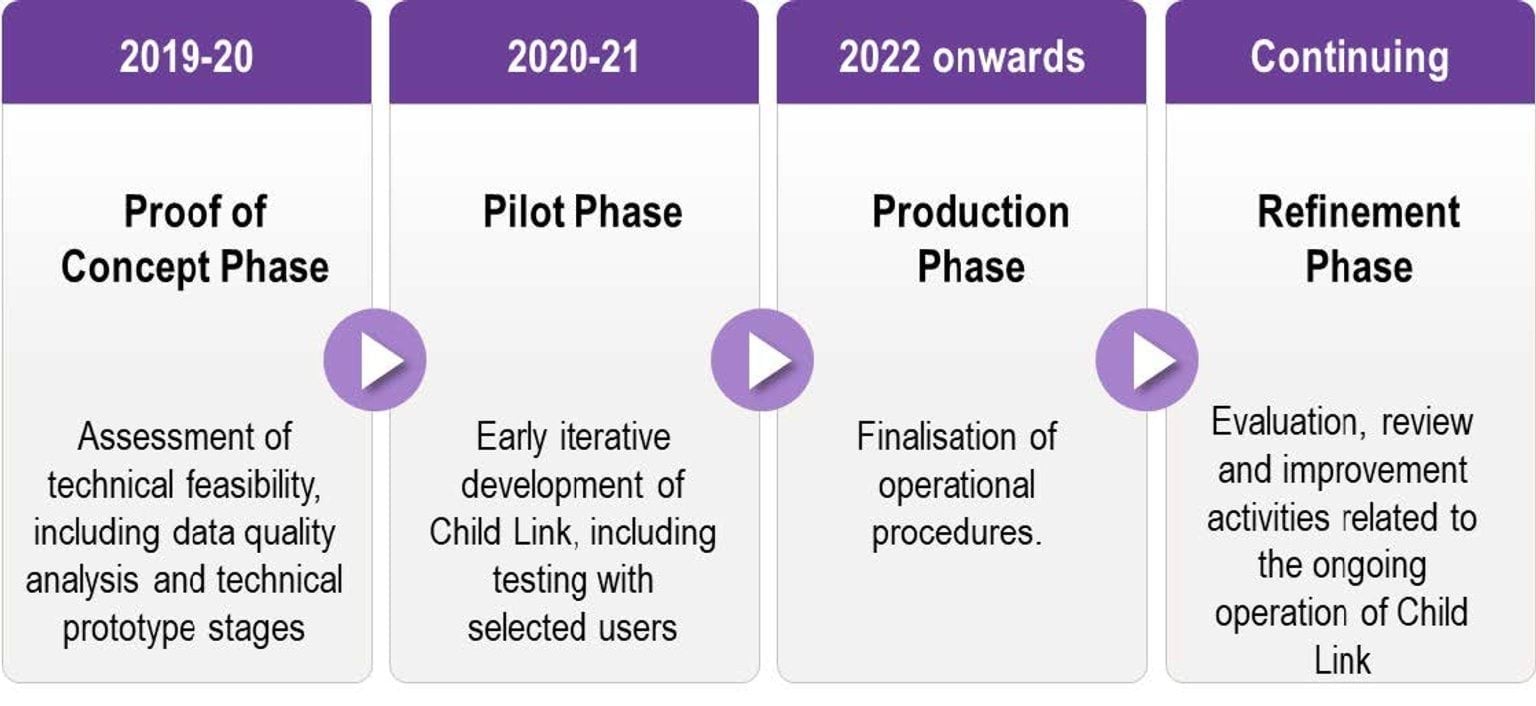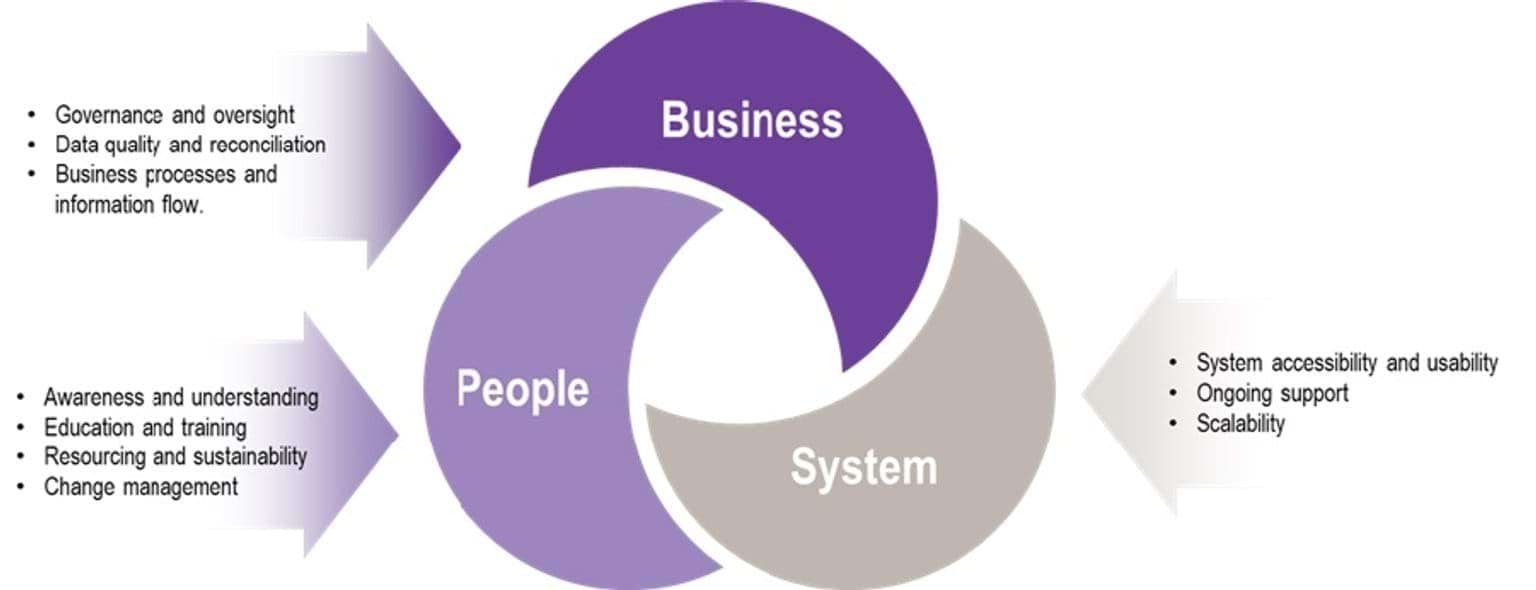1.1 Victorian Child Information Sharing Reforms and Child Link
1.1.1 The Victorian Child Information Sharing Reforms
The Victorian Child Information Sharing (VCIS) reforms were developed in response to several inquiries, including the Royal Commission into Institutional Responses to Child Sexual Abuse, where recommendations were made to increase the protection of vulnerable children by simplifying and improving information sharing arrangements between trusted organisations and professional entities. These reforms include the Child Information Sharing (CIS) Scheme and the establishment of the Child Link Register (also referred to as Child Link).
Together, the CIS Scheme and Child Link are expected to1:
- improve early needs and risks identification and support, by permitting professional and respectful sharing of information early
- change a risk averse culture in relation to information sharing, in part by simplifying the legislation
- increase collaboration and integration between child and family services, promoting shared responsibility across organisations that provide services to children and families
- support children’s and their families’ participation in services to which they are entitled.
1.1.2 Child Link
Requiring the establishment of Child Link responds to specific recommendations from earlier inquiries and reviews seeking to ensure data systems and practices optimise identification of all vulnerable children who could benefit from early intervention supports, and proposing development of a system to track their engagement with services at key stages of childhood. It was envisaged that the proposed Child Link Register would operate as ‘an IT enabler that will draw key fields of information from pre-existing government information management systems and display the information in a web-based platform only accessible by a restricted group of authorised professionals’2.
The subsequent legislative reform of the Act to implement the Child Information Sharing reforms includes Part 7A to establish the Child Link Register. The objective of Part 7A is ‘to establish the Child Link Register to improve child wellbeing and safety outcomes for, and to monitor and support the participation in government-funded programs and services, by children born or resident in Victoria’ (Child Wellbeing and Safety Act s1(fb)).
Child Link brings together data from other existing information systems into a single and aggregated source of information. It will include information on all children born in or residing in Victoria and may include information on their engagement in key childhood and funded government services, such as Maternal and Child Health services, early childhood education and schooling (including home schooling), Child Protection and other care services. It is intended that Child Link will assist organisations prescribed under the CIS Scheme by providing authorised users of the Register with critical information about the children in their care so that they can:
- make more informed decisions about the wellbeing, safety, and support needs of a child within their service
- better identify needs, issues and vulnerabilities that may be present to prevent an escalation of harm
- collaborate with other professionals working with the child and family.
The legislation authorises the Secretary of the Department of Education and Training to collect, use and disclose information for the purposes of developing and maintaining Child Link. Division 4 of the legislation authorises a subset of authorised organisations and services (information sharing entities (ISEs)) under the CIS Scheme to access Child Link and to use the confidential information contained within for purposes stated within Schedule 6 of the Act, or in line with Part 6A, which relates to the CIS Scheme.
Child Link is intended as a collection of key information recorded in existing childhood data systems with limited potential for bias and judgement when accessing and interpreting the information.
1.1.3 Progress to date
The Child Link program is being established through a phased approach with funding to date on a year-by-year basis, supported by a detailed plan underpinning the annual business case. An overview of the program phases from establishment to implementation and beyond is provided in Figure 1.1 (Overview of the phased approach to implementation).
The first phase of the program culminated in the Proof of Concept (PoC), which was funded during the 2019-20 financial year. The purpose of the PoC phase was to conduct essential research to ascertain the core requirements for the commissioning of Child Link. The PoC phase included two distinct stages – the data analysis stage and the technical prototype stage. The data analysis stage involved a detailed assessment of the data from source systems that would be required to develop and maintain child profiles within Child Link, while the technical prototype stage established the potential availability of technological platforms to create the child profiles from source data.
The next and current phase of the program is the Pilot Phase, which commenced in July 2020. This phase will continue until the completion of the Child Link solution, which is legislatively mandated to occur prior to 31 December 2021. The Pilot Phase will:
- build and implement the required Child Link platforms in an agile, iterative manner
- extract child data from all available source data systems
- on-board a select number of Child Link users from across the sector to conduct validation activities on child profiles, which will assist with tailoring of system functionalities to meet the needs of users.
From 2022, the Production and Refinement phases will focus on progressive rollout of Child Link to a broader workforce estimated to be around 25,000 staff members,
with a range of system enhancement and expansion activities to support different workforces as they come online.
1.2 Purpose of this Review
An independent review of Child Link is required under Section 46X of the Act, to be undertaken two years from commencement of the legislation. This Review, commissioned by DET, covers a period that includes the PoC phase and a significant proportion of the Pilot phase, and is required to consider the development of Child Link to date, with a particular focus on:
- consideration of the adequacy of the design of the Child Link implementation program, and policy planning, in achieving the legislative intent of Part 7A of the Act
- identification of any likely future adverse effects of the design of the Child Link implementation program and policy planning, within the Review period
- making recommendations on any matter addressed in the Review to inform future phases of Child Link.
1.3 Review methodology and approach
The Review methodology involved document review and stakeholder consultations targeting key informants. The document review included approximately 50 different documents covering a broad span of activities. The documents related to the first two phases of the program and included final and draft material reflecting the continuous developmental work over the first two years to establish Child Link. Documents broadly related to:
- phased implementation approach
- governance and assurance activities
- proof of concept and pilot strategy
- stakeholder communication planning
- frameworks for monitoring and measurement of the initiative.
In addition to the document review, in-depth interviews were held with key staff within the Department’s Victorian Child Information Sharing (VCIS) team, who are responsible for the implementation of both the CIS Scheme and Child Link, as well as a selection of key members from the Child Link Board. The Child Link Board is the highest governance body for Child Link and reports to the Secretary of the Department and the responsible Ministers.
1.4 Review framework
A review framework was developed that considered the key objectives of the Review (see section 1.2), overlaid across three key areas of focus relating to people, business and system. These key areas of focus are illustrated below.
1.5 Structure of this report
The structure of this report is aligned to the review framework as follows:
- Chapter 2 examines the findings in relation to Key Review Question 1: Does the design of the Child Link implementation program and its implementation to date support the legislative and policy intent of Part 7A of the Act?
- Chapter 3 examines the findings in relation to Key Review Question 2: Does the policy planning in support of implementation and ongoing operation and monitoring of Child Link support the legislative and policy intent of Part 7A of the Act?
- Chapter 4 examines the findings in relation to Key Review Question 3: Is the design of the Child Link implementation program, its implementation to date and the policy planning in support of Child Link likely to have any adverse impacts?
- Chapter 5 provides a summary of the Review findings and recommendations to inform future phases of the Child Link program?
Updated

